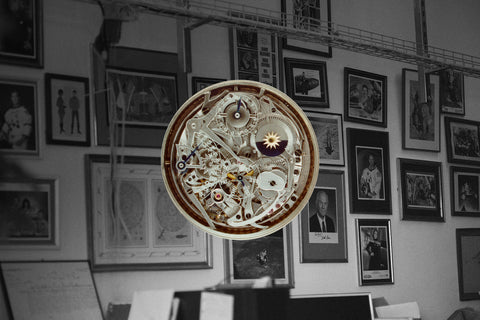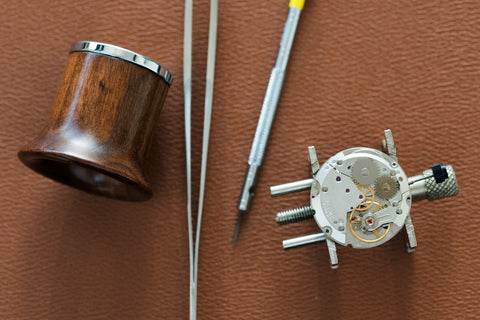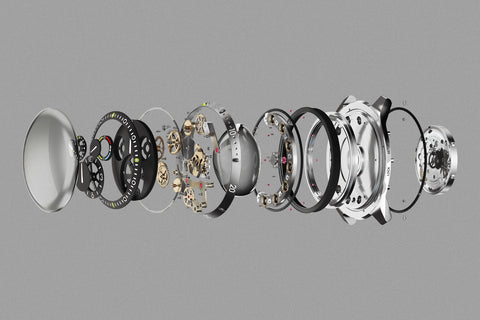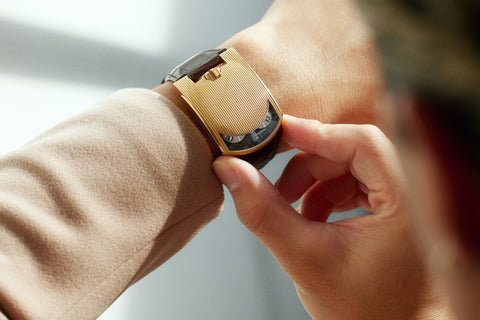This Open Dial Series 2 sits at an intriguing transitional point in the English watchmaker's work. On the one hand, the layout of the watch bears a stronger resemblance to the watches Smith creates today, while on the other, the watch possesses many of the characteristics that more typically belong to earlier Series 2 pieces. Another point to note is that while some open-dial Series 2 pieces were created, these were then turned into their own Series 5, made under that designation, thus making it rarer to hear of an "open-dial Series 2".
The Co-Axial Escapement
The Co-Axial was devised in the early 1970s and patented in 1980, with its design based on a series of experimental escapements that started in 1969. It was designed to improve the mechanisms’ long term performance by radically changing the nature of its inner workings. This was the first practical invention since the lever escapement, created by Thomas Mudge in 1755, thus representing an important advancement in the dynamics of the watch. By re-designing the function of the components during impulse, the Co-Axial Escapement operates without sliding friction. As a consequence, unlike a conventional watch, the rate is unaffected by the viscosity of lubricants, which can vary constantly with temperature, humidity, and age.
In 2006, Smith began working on his own interpretation of his mentor's design, culminating in the first significant development of the Co-Axial Escapement. He spent years studying ways to improve its efficiency and accuracy. Initially combining two wheels, Smith created his first single-wheel design in 2010. Through successive versions, it was discovered that the lighter the escape wheel, the better it performed.
In the original paperwork for this watch, Smith refers to this Series 2 Open Dial as being the first to house his latest, “much lightened” single-wheel escapement, which was first introduced in 2015. Despite further examples having been made since, this first iteration of Roger’s most recent refinement marks another key step in his long-standing journey to carry forward Daniels’ legacy.
The Design
Where previous iterations of the Series 2 have been more restrained and traditional, this open-dial version is Smith's compelling attempt at disrupting the buttoned-up image of British watchmaking. The open-dial features a thin, outer-chapter of engraved, black minute markers, with corresponding Roman numerals indicating the hours. The dial features English-style flourishes, with frosted and gilded plates, gold chatons, and flame-coloured screws. All parts are hand-crafted from beginning to end; including the slender, purple-flamed gold hour and minute hands, tipped with spades. A raised cartouche at twelve o'clock references "R. W. SMITH" in black engraving, and likewise for the reverse of the watch.
A power-reserve indicator sits at 10 o'clock, with a purple-flamed up/down hand, with a hanging chapter made from silver. The large, sub-seconds register placed at six o'clock is also enclosed within a grained silver seconds chapter with drilled dots to mark the seconds, while the hand features a traditional counterbalance on the other end.
The traditional movement is revealed through the sapphire case-back, and is very much inspired by the British-style of pocket watches from makers such as Tompion, Graham and Arnold. It has understated, English frosted finishings in a combination of warm, golden tones, creating a striking backdrop for the blue screws. A raised barrel bridge and balance cock add a revealing depth to the movement. This, together with the dominating three-quarter main plate, is a testament to Roger W. Smith's commitment to traditional English watchmaking.








































































































































































































































































